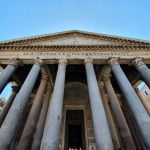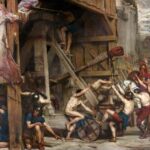Pantheon in Rome1, in other words, “Temple of all Gods” is a round temple built in 125 CE in honour of the seven most important Roman deities. The name functions less frequently: Pantheum. In that way it appeared in “Natural History” Pliny the Elder (XXXVI.38) in the description of that building: Agrippae Pantheum decoravit Diogenes Atheniensis; in columnis templi eius Caryatides probantur inter pauca operum, sicut in fastigio posita signa, sed propter altitudinem loci minus celebrata.
This building was founded by Mark Agrippa and on his orders designed. The structure was built in the Martian Field on the site of a former temple in honour of the divine patrons of Rome, built in 27 BCE and destroyed in a fire in 80 CE. Emperor Domitian rebuilt the building, but it was destroyed again in the fire of 110 CE.
In the later rebuilding (in the 20s of the second century CE) by the Hadrian Pantheon other inscriptions of Agrippa. The portico of the Pantheon was supported by twelve columns, each about 12 meters high, carved from one block of grey granite from Egypt. This stone was extremely prestigious in ancient Rome because it was mined in only one place – at a distance of more than 4, 000 km from Rome – “Claudius Mountain”2 (Mons Claudianus), located in the middle of the East-Egyptian desert. Delivering 12 large rock blocks from such a distance required a huge amount of work and resources.
The pantheon was built on a circular plan and differed from the previous temple. Only the original portico, which was not destroyed during the fire of 80 CE, has been preserved. The construction was managed by Apollodoros of Damascus later and executed by order of the emperor for criticizing the double temple of Venus and Roma, designed by Hadrian.
The Pantheon is a rotunda with a diameter and a height of 43 metres. The building is covered with a huge dome cast in concrete, at the base of which the thickness is 7 meters. The dome of the building has a central hole on top, called the “eye” (oculusem) with a diameter of 9 metres, which is the only opening that illuminates the interior. As the opening has no cover, the floor in the middle is slightly concave with a rainwater outlet. The palate of the dome is decorated with five rows of coffers.
In front of the entrance to the temple, there is a three-row portico of 16 columns in Corinthian order, each 14 meters high. 8 of the 16 columns are in the first row.
It is crowned with a tympanum under which the inscription appears:
M·AGRIPPA·L·F·COS·TERTIVM·FECIT
M[arcus] Agrippa L[ucii] f[ilius] co[n]s[ul] tertium fecit
means:
Built by Marcus Agrippa, son of Lucius, consul for the third time.
A huge, heavy 20-ton bronze door leads to the interior of the Pantheon. In ancient times, the inner wall lined with granite and yellow marble was probably crossed by seven evenly spaced niches for seven bronze deities:
- Sun – god Apollo or Sol.
- Moon – goddess Diana or Luna.
- Mars – god of war.
- Mercury – god of trade.
- Jupiter – the highest god.
- Venus – goddess of love.
- Saturn – god of agriculture and time.
The seven planetary deities corresponded to the classical celestial bodies visible to the naked eye. These deities were associated with the days of the week and planets known to the ancient Romans. Each of these deities had its place in Roman cosmology and played an important role in the religious life of the inhabitants of the Roman Empire.
The Pantheon is the best-preserved building from the time of ancient Rome. There used to be a ceremonial altar inside, where animals were sacrificed and burned. During the ritual, smoke was emitted through oculus, which was called the “all-seeing eye of heaven”.
In 202 CE, the building was repaired during the reign of Septimius Severus and his son Caracalla what we know about, due to the preserved inscription on the arched facade:
IMP · CAES · L · SEPTIMIVS · SEVERVS · PIVS · PERTINAX · ARABICVS · ADIABENICVS · PARTHICVS · MAXIMVS · PONTIF · MAX · TRIB · POTEST · X · IMP · XI · COS · III · P · P · PROCOS ET
IMP · CAES · M · AVRELIVS · ANTONINVS · PIVS · FELIX · AVG · TRIB · POTEST · V · COS ·PROCOS · PANTHEVM · VETVSTATE · CORRVPTVM · CVM · OMNI · CVLTV · RESTITVERVNT
means:
Emperor Caesar Lucius Septimius Sever Pius Pertynaks, winner from Adiabene, Grand Conqueror of the Parties, Pontifex Maximus, 10-fold stand, 11-fold emperor, 3-fold consul, Pater Patriae, pro consul and
Emperor Caesar Mark Aurelius Antoninus Pius Felix Augustus five times the stand, consul, proconsul carefully renovated the Pantheon destroyed over the years.
The building was taken over by Christians around 600 CE, claiming that the Pantheon is the home of demons. They transformed it into a Catholic church of Santa Maria Ad Martyre The Blessed Virgin Mary of the Martyrs.










